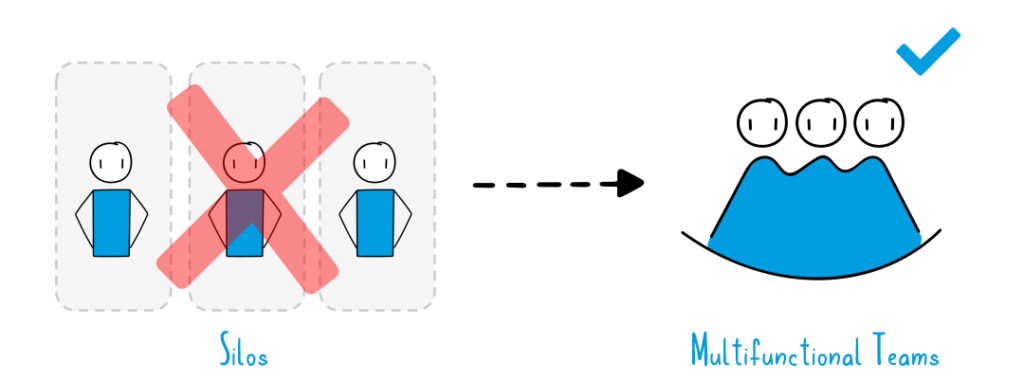Scrum in 5 Minutes: An Incremental and Iterative Strategy-EN

Gabriel Casarini
- Business Agility
- Article
Project management is hardly seen any more as a rigid division of tasks. Instead, it is addressed dynamically with techniques, tools, and processes that help make operations more fluid and able to quickly produce tangible results. But we could also say that the planning and execution of projects has not changed dramatically in recent decades… many still prefer to have well-defined processes and steps to follow at all times.
Scrum is popular as a framework because it offers a balanced mix of prescription and versatility to accommodate the reality of each organization, team, and project. Are the customer’s requirements changing? Is there uncertainty in the scope of the project? Scrum and agile frameworks are the best alternative. However, if it is a simple, repeatable project with little uncertainty then most traditional and predictive management methods (waterfall) are enough.
Scrum is a simple, team-oriented framework that is highly effective in solving complex problems. Although its primary area of application is software development, it has slowly been adopted in other disciplines, including manufacturing and services.
Scrum promotes common sense, direct communication, and continuous improvement among its participants. And as we mentioned before, although its origins go back to software development, nothing in Scrum is software-specific.

The fundamental characteristic of Scrum is that it divides the work into small, iterative cycles called sprints. This cyclical way of working allows us to approach a large and complex project as a sequence of small, manageable fragments over time. The goal is to build little by little, incrementally and quickly validating an element before making new decisions to start the construction of another element in the next sprint. Build. Validate. Adjust. Build. Validate. Adjust…
Rhythm and Roles
As with bars on sheet music, Scrum sprints set the pace of construction. During each sprint, the team works collaboratively to perform the tasks necessary to build the product. The characteristics of these tasks depend on the very nature of the project. For software, teams typically do some analysis, design, programming, testing, and deployment. The goal is to have something concrete to show at the end of each sprint.
In essence, Scrum invites teams to regularly compare the status of their work — progress — against the reality of the expectations and needs of customers, users, and stakeholders. We must ensure that both sides are perfectly aligned and that the team can quickly adapt to new circumstances and incorporate more ideas.
The Scrum Guide is a short, easy-to-read document that defines the basis for organizing work. Without being simplistic about the challenges of developing complex products, the guide only limits itself to defining a few rules. That lack of precision often baffles teams who are looking for magic recipes and detailed instructions. We have the parts and minimum instructions to start the machinery. The lack of rigidity leaves us room to adapt the process to the reality and circumstances of the organization.
Scrum Roles
There are three well-defined roles in the team that work collaboratively:
- The Product Owner has a mandate to maximize the value delivered to the customer, set priorities, and make all decisions related to the product.
- The Development Team builds the product guided by the PO’s priorities. The role of the development team must be interpreted broadly and also include other disciplines such as product promotion, marketing, and branding.
- The Scrum Master has the mission of creating a safe, agile environment so that the entire team can work effectively. He is responsible for implementing continuous improvement throughout the process.
Scrum as a Change Agent
As in chess, the few Scrum rules are easy to explain and understand. Also like in chess, applying Scrum correctly takes time, practice, and experience. Obviously, Scrum is attractive for its potential advantages: value delivery, speed, transparency, etc., but it also provides other benefits that better explain its nature as an effective framework:
- Self-Organization: The Scrum team is a self-organized and self-managed unit capable of making independent decisions and assuming responsibilities. This increases productivity and engagement.
- Teamwork: Without formal hierarchy, the primary task of each member is to collaborate and take responsibility for the results.
- Cross-Functional Teams: Unlike typical silo-based organizational structures, Scrum encourages cross-functional with teams that incorporate all the competencies necessary to build the product.
- Customer-Centric Process: Scrum assigns the Product Owner the responsibility of ensuring that the product developed is perfectly aligned with the customer’s needs and priorities. Incremental and iterative development is the secret formula to achieve this.
- Empirical Control and Continuous Improvement: Progress is measured by results. The team continually seeks to increase its agility and quality — of the product and the process.
Silo-based organizational structures that operate with long development cycles no longer serve to respond to today’s challenges. The pace of change is accelerating, and agile transformation is no longer a goal pursued only by technology companies. As we move into the digital age, it is important that all organizations become more agile.
In this sense, Scrum is certainly an agent of change. The (correct) implementation of Scrum inevitably leads to a change in organizations’ mindset and structure: they are simplified, flattened, become more transversal, and are capable of responding quickly and more effectively to changes.

One of the first keys to achieving the productivity benefits that Scrum promises is to gain broad and committed support from all levels of the organization: bottom-up and top-down. Once the decision to use Scrum has been made, it is important to establish a frame of reference for new roles and ways of working — because Scrum has much more to do with people than with techniques. Adopting this way of working requires a learning phase that can take time.
For organizations that have not taken the first steps or are in the early stages of the transformation processes, it is important to start with a pilot project that will lead to the first success story. Expert training and support are critical to designing a realistic roadmap for success.
I’ll end with a phrase from Mike Cohn that sums up the challenge of adopting Scrum:
“Changing practices is one thing; changing minds is quite another.”
If you would like to learning more about Scrum, I recommend taking a look at our Agile Fundamentals course. As a bonus, students will also receive ICAgile’s ICP Fundamentals certification!
All the best,
— Gabriel
